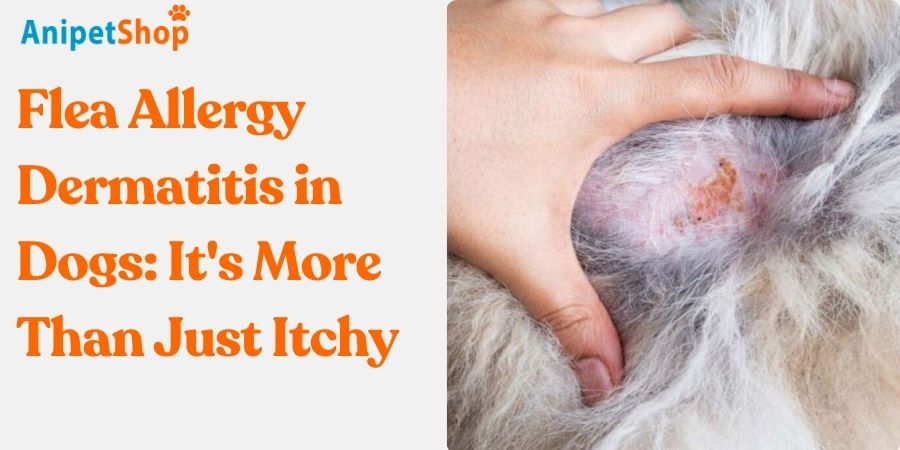Flea Allergy Dermatitis in Dogs: It’s More Than Just Itchy
Not merely a minor annoyance, flea saliva can cause an allergic reaction known as flea allergy dermatitis (FAD). A single flea bite can set off a severe and unending cycle of excruciating itching, skin irritation, and other distressing symptoms in dogs suffering from this ailment. If left untreated, FAD can have a major negative influence on a dog’s quality of life, therefore it’s critical to comprehend this complicated illness and learn appropriate management techniques.

What Are Allergic Dogs?
Allergic reactions or flea allergy dermatitis (FAQs) and sensitivities in dogs, particularly those triggered by fleas, are quite common. In fact, around 7% of visits to veterinary clinics and animal hospitals involve skin conditions like allergic dermatitis and pruritus, which can stem from food sensitivities, flea bite hypersensitivity, or reactions to environmental irritants like pollen and mold (Today’s Veterinary Nurse).
Canine atopic dermatitis (CAD), a chronic form of allergic skin disease, affects approximately 10% of dogs and is often worsened by exposure to allergens such as pollen, mold, and dust mites (BioMed Central). Flea allergy dermatitis, a specific type of allergic reaction, is particularly prevalent in dogs. It occurs when a dog reacts to proteins in flea saliva, leading to intense itching, inflammation, and discomfort.

Signs and Symptoms of Flea Allergy Dermatitis
Flea Allergy Dermatitis affects a significant portion of the canine population. Here is signs and symptoms of flea allergy dermatitis:
- Intense Itching (Pruritus): Studies have shown that the primary symptom of FAD is severe pruritus, with affected dogs spending a considerable amount of time scratching, biting, and licking. A study published in Veterinary Dermatology found that dogs with FAD had significantly higher pruritus scores compared to non-allergic dogs.
- Hair Loss (Alopecia): The incessant scratching and chewing associated with FAD often leads to alopecia. This hair loss is typically concentrated around the base of the tail, hindquarters, and inner thighs, as these areas are more accessible for the dog to reach.
- Skin Redness (Erythema) and Inflammation: The allergic response to flea saliva triggers inflammation in the skin, resulting in visible redness and irritation. A histological examination of skin biopsies from dogs with FAD reveals infiltration of inflammatory cells, further confirming the inflammatory nature of the condition.
- Papules and Pustules: These skin lesions are a common manifestation of FAD. Papules are small, raised bumps, while pustules are similar but filled with pus. These lesions are often found in areas where fleas are most likely to bite, such as the abdomen and groin.
- Hot Spots (Acute Moist Dermatitis): Hot spots are localized areas of intensely inflamed skin that can develop rapidly due to self-trauma. They are often moist and can become infected, leading to further complications.
- Skin Infections (Secondary Infections): The compromised skin barrier caused by scratching and biting predisposes dogs with FAD to secondary bacterial and yeast infections. A study in the Journal of the American Veterinary Medical Association found that over 50% of dogs with FAD also had secondary skin infections.
- Behavioral Changes: The constant discomfort and itching associated with FAD can significantly impact a dog’s behavior. Affected dogs may become restless, agitated, and irritable, affecting their overall quality of life.

A study published in Veterinary Dermatology estimated that the prevalence of FAD in dogs ranges from 12.5% to 41%, depending on the geographic location and flea infestation rates.
Another study in the Journal of Veterinary Internal Medicine found that FAD was the most common cause of allergic skin disease in dogs, accounting for 30% of cases.
Diagnosing Flea Allergy Dermatitis
A study published in Veterinary Dermatology found that combining clinical signs with the presence of fleas or flea dirt had a sensitivity of 88.9% and specificity of 85.7% for diagnosing FAD. Another study in the Journal of the American Veterinary Medical Association reported that intradermal skin testing had a sensitivity of 92% and specificity of 75% for diagnosing flea allergies.
Accurately diagnosing Flea Allergy Dermatitis requires a multi-faceted approach combining clinical observations, exclusion of other conditions, and evidence of flea infestation.
- Clinical Signs (Symptoms)
Veterinarians meticulously assess the presenting signs and symptoms, focusing on:
-
- Distribution of Lesions: The characteristic distribution of skin lesions is a significant clue. In FAD, lesions often concentrate around the base of the tail, hindquarters, inner thighs, and abdomen—areas easily accessible for a dog to scratch and bite.
- Type of Lesions: Veterinarians examine the specific types of skin lesions present, such as erythema, papules, pustules, and hot spots. The presence of these lesions, especially in the characteristic distribution, strongly suggests FAD.
- Ruling Out Other Itchy Skin Conditions
Several other conditions can mimic FAD, causing similar itchy skin symptoms. Therefore, veterinarians must systematically exclude these differentials:
-
- Sarcoptic Mange: Caused by mites, this condition can cause intense itching and hair loss. Skin scrapings are used to identify the mites under a microscope.
- Food Allergies: Food allergies can manifest with skin symptoms similar to FAD. A dietary elimination trial is often employed to diagnose food allergies.
- Other Allergies: Allergies to environmental allergens like pollen and dust mites can also cause itchy skin. Intradermal allergy testing or serology testing can help identify these allergies.
- Evidence of Flea Activity
The presence of fleas or flea dirt (flea feces) on the dog’s body is strong evidence supporting the diagnosis of FAD. Veterinarians may use a flea comb to detect fleas or their excrement.
- Specialized Allergy Testing
In some cases, where the diagnosis remains unclear despite the above steps, specialized allergy testing may be necessary.
-
- Intradermal Skin Testing: This test involves injecting small amounts of potential allergens (including flea saliva) under the skin and observing for reactions.
- Serology Testing: This blood test measures the presence of antibodies against specific allergens, including flea saliva.
Please note that the diagnostic process may vary slightly depending on individual cases and available resources. It’s always best to consult with a veterinarian for an accurate diagnosis and appropriate treatment plan.
Treating Flea Allergy Dermatitis
Flea Control
Effective flea control is the cornerstone of managing FAD. It involves eliminating fleas from the pet and its environment.
Effective flea control is the cornerstone of managing Flea Allergy Dermatitis (FAD) and involves eliminating fleas from both the pet and its environment. Topical treatments such as Fipronil (Frontline, PetArmor), applied once a month between the shoulder blades, and Imidacloprid (Advantage, Advecta), which also requires monthly application, kill fleas on contact. Oral medications offer another layer of control; Nitenpyram (Capstar) provides rapid relief by killing adult fleas within 30 minutes and is effective for short-term control, while Spinosad (Comfortis, Trifexis) offers longer-term protection by killing fleas for a month after a single dose.
Environmental control is equally important: regularly vacuuming all areas where the pet spends time, focusing on carpets, rugs, and upholstered furniture, helps remove fleas and their eggs. Washing pet bedding, blankets, and other fabric items in hot water is crucial for eliminating fleas. Additionally, using flea sprays and foggers containing insect growth regulators (IGRs) like methoprene or pyriproxyfen can prevent flea eggs from hatching and help treat larger areas, ensuring a flea-free environment.

Symptomatic Relief
Managing the symptoms of Flea Allergy Dermatitis (FAD) is essential. Antihistamines like Diphenhydramine (Benadryl) and Hydroxyzine help reduce itching, with dosages set by a veterinarian.
Corticosteroids, such as Prednisone or Prednisolone, provide short-term relief for severe itching and inflammation. For more severe cases, Dexamethasone is used under veterinary supervision.
Topical treatments, including shampoos with oatmeal or hydrocortisone, and anti-itch sprays with lidocaine or pramoxine, soothe irritated skin and offer immediate relief.

Treating Secondary Infections
Secondary infections often result from excessive scratching and biting, leading to open sores and bacterial or fungal infections. Antibiotics like Cephalexin are commonly prescribed for bacterial skin infections (pyoderma), while Clindamycin is used to treat infections, particularly those caused by Staphylococcus bacteria. For fungal infections, Ketoconazole is effective in treating conditions like ringworm, and Itraconazole may be prescribed based on the type and severity of the infection.
Prevention
Prevention is key to managing FAD and ensuring the pet remains flea-free. Regular flea prevention involves using year-round preventatives and combination products that protect against multiple parasites. Routine grooming, such as regular baths with flea-control shampoos and frequent brushing, helps detect and remove fleas early. Environmental maintenance includes placing flea collars in vacuum bags to kill fleas and treating the yard with insecticides, especially in shady and moist areas where fleas thrive.
Conclusion
Allergy to fleas Although dermatitis is a difficult condition, your dog can have long-lasting comfort and a high quality of life if you and your veterinarian work together effectively. Maintain vigilance, heed your veterinarian’s advice, and take preventative measures to control this allergic reaction.
Lily Watson is an author specializing in veterinary care in Australia. With a profound passion for animal welfare and a solid foundation in veterinary science, Lily has dedicated herself to disseminating valuable knowledge and information for both pet owners and professionals in this field.

